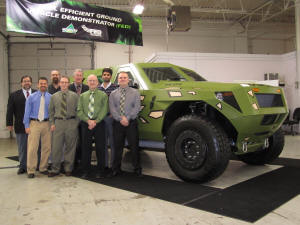FED Bravo PROGRAM
The Fuel Efficient Ground Vehicle Demonstrator Program (FED) was a vehicle design and build program sponsored by the US Army’s Tank Automotive Research, Development and Engineering Center (TARDEC). As the US military concentrates its efforts to reduce our country’s dependence on foreign oil, TARDEC is committed to exploring emerging technologies that can contribute to the fuel efficiency of its existing legacy fleet as well as new vehicle builds. The FED Program explored a variety of state-of-the-art fuel saving approaches including lightweight materials, hybrid propulsion, and optimized vehicle systems to design a concept vehicle from the ground up that incorporated these approaches into a single demonstrator to testing purposes. The final design triples the fuel economy of the standard HMMWV.
I was brought on to work for World Technical Services, Inc. (WTSI), the company responsible for the design and build phases of the FED Bravo Program. I joined the FED team at the tail end of their design phase.
Their primary electrical engineer had left for another career opportunity,
so I was hired to assess the state of the vehicle’s current electrical architecture, interface with electrical subcontractors, recommend a plan to put the electrical design back on schedule, and execute the design, assembly, and troubleshooting phases
of the program during vehicle assembly. I soon realized that the design was incomplete and way behind schedule. So within an extremely compressed timeline, I was able to execute a plan to design OEM level wiring harnesses and circuit protection to control all low voltage vehicle systems on the FED Bravo prototype. Point to point harnesses linking all systems were then fitted and installed by me along with heavy gage wiring linking the battery with its associated high current onboard systems. I spend several weeks stripping wire and crimping on connectors as the build slowly came together. Completing these tasks ahead of schedule, I began assisting the Hybrid Powertrain Contractor to wire up and install their systems as well. When the power was activated, I spent a significant amount of time testing and evaluating each subsystem utilizing a systematic approach to ensure proper functionality.
FED Bravo debuted in a hand off ceremony to TARDEC on December 14, 2011. All who attended were very impressed by the workmanship and integration effort that was executed by a build team of twelve highly skilled individuals. Taking this vehicle design from a clean sheet to a working prototype in nine months was an incredible feat. Rapid Vehicle Prototyping is a unique skill set that you really need the right people in order to execute successfully.


